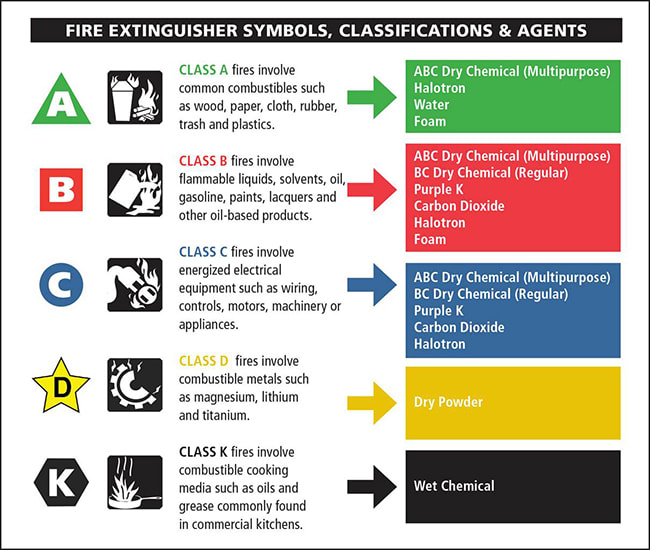Types of Fires
Not all fires are the same – some burn faster and are more dangerous, and most importantly, not all fires can be put out or suppressed the same way. Understanding the different types of fire classes can help determine how to best prepare in case of a fire emergency.
Fire is divided into five classes (A, B, C, D, and K) that are primarily based on the fuel that is burning. This classification system helps to assess hazards and determine the most effective type of extinguishing agent.
Classes of Fires
Class A Fires
The most common class, these fires involve common combustibles such as wood, paper, cloth, rubber, trash, and plastics.
Class B Fires
These Involve flammable liquids, solvents, oil, gasoline, propane, butane, paints, lacquers, and other oil-based products or petroleum-based products.
Class C Fires
Old wiring and space heaters are common causes for residential Class C fires, which involve energized electrical equipment such as wiring, controls, motors, machinery, or appliances.
Class D Fires
While Class D isn’t as common, they can be more difficult to extinguish. They typically involve combustible metals such as magnesium, lithium, potassium, and titanium. This type of fire is more commonly seen in laboratories.
Class K Fires
While Class K fires also involve flammable liquids, these are related to combustible cooking materials such as oils and grease commonly found in kitchens. Class K fires can spread quickly and be the most difficult to manage, especially since water can make the situation worse.
Choosing the Right Type of Fire Extinguisher
Choosing the right type of fire extinguisher for a corresponding fire class is essential when preparing for a fire emergency. Here’s how to suppress different types of fire classes:
Fire Class | How to Suppress | Fire Extinguisher |
|---|---|---|
Class A | Water or Smother | Water, Foam, ABC Dry Chemical, Halotron |
Class B | Smother | CO2, Halotron, ABC dry chemical, BC dry chemical, Purple K, Foam |
Class C | Non-conductive chemical | ABC dry chemical, BC dry chemical, Purple K, CO2, Halotron |
Class D | Dry powder agents | Dry Powder |
Class K | Smother, Wet chemical | Wet Chemical |

Choosing a Fire Extinguisher for Your Home
Fire extinguishers can help save lives and protect property - the number one priority in any house fire is to escape safely.
Types of Fire Extinguishers - For Business
Learn the basics of commercial fire safety. Choosing the right commercial fire extinguisher is the first step in fire safety for your business and it just so happens to be the most important.
How to Use a Fire Extinguisher
Learn the four-step PASS procedure recommended by the National Fire Protection Association for How to Use a Fire Extinguisher. how to use fire extinguisher
Fire and Carbon Monoxide Safety Tips
Protect your home and family from the dangers of fire and carbon monoxide. Install smoke detectors and carbon monoxide alarms on every floor of your home.
Types of Fire Extinguishers
There are many different types of fire extinguishers on the market, each with specialized capabilities. Each fire extinguisher is designated by: type, class & rating.
What Causes Consistent Chirping?
Learn more about the conditions that could cause your smoke alarm to chirp consistently.